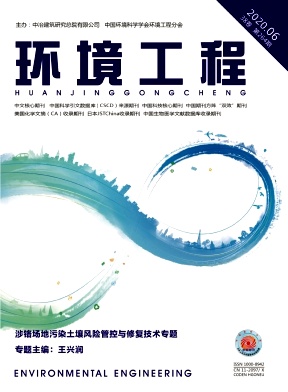|
DIACONU M, PAVEL L V, HLIHOR R M, et al. Characterization of heavy metal toxicity in some plants and microorganisms: a preliminary approach for environmental bioremediation[J]. New Biotechnology, 2020, 56: 130-139.
|
|
WEN Q X, WANG Q, LI X Q, et al. Enhanced organics and Cu2+ removal in electroplating wastewater by bioaugmentation[J]. Chemosphere, 2018, 212: 476-485.
|
|
LI X, WU Y E, ZHANG C, et al. Immobilizing of heavy metals in sediments contaminated by nonferrous metals smelting plant sewage with sulfate reducing bacteria and micro zero valent iron[J]. Chemical Engineering Journal, 2016, 306: 393-400.
|
|
CHEN X, CUI J, XU X R, et al. Bacterial cellulose/attapulgite magnetic composites as an efficient adsorbent for heavy metal ions and dye treatment[J]. Carbohydrate Polymers, 2020, 229:115512.
|
|
PAP S, J RADONIC', S TRIFUNOVIC', et al. Evaluation of the adsorption potential of eco-friendly activated carbon prepared from cherry kernels for the removal of Pb2+, Cd2+ and Ni2+ from aqueous wastes[J]. Journal of Environmental Management, 2016, 184: 297-306.
|
|
FERRI M, CAMPISI S, SCAVINI M, et al. In-depth study of the mechanism of heavy metal trapping on the surface of hydroxyapatite[J]. Applied Surface Science, 2019, 475: 397-409.
|
|
李明, 程寒飞, 安忠义, 等. 化学淋洗与生物质炭稳定化联合修复镉污染土壤[J]. 环境工程学报, 2018, 12(3):904-913.
|
|
张志红, 陈家煜, 郭观林, 等. 稳定剂协同水泥固化/稳定化重金属污染土壤的工程特性[J]. 环境工程学报, 2017, 11(5):3172-3178.
|
|
陈亚奎, 卢滇楠. 重金属污染土壤生物修复技术研究进展与现状[C]//2019中国环境科学学会科学技术年会论文集(第三卷), 2019: 564-568.
|
|
朱玉斌. 土壤重金属污染现状及修复技术比较[J]. 中国资源综合利用, 2017, 35(5):56-58.
|
|
YU H W, ZOU W X, CHEN J J, et al. Biochar amendment improves crop production in problem soils: a review[J]. Journal of Environmental Management, 2019, 232: 8-21.
|
|
NIE C, YANG X, NIAZI N K, et al. Impact of sugarcane bagasse-derived biochar on heavy metal availability and microbial activity: a field study[J]. Chemosphere, 2018, 200: 274-282.
|
|
张杏锋, 冯健飞, 姚航, 等. 美洲商陆生物炭对Zn、Pb、Cd和Cu的吸附特性分析[J].环境工程, 2019, 37(8):88-94.
|
|
LU X Q, LIU X W, ZHANG W Q, et al. The residue from the acidic concentrated lithium bromide treated crop residue as biochar to remove Cr (Ⅵ)[J]. Bioresource Technology, 2020, 296: 122348.
|
|
熊静, 王蓓丽, 刘渊文, 等. 生物炭去除土壤重金属的研究进展[J].环境工程, 2019, 37(9):182-187.
|
|
SHEN Z T, HOU D Y, JIN F, et al. Effect of production temperature on lead removal mechanisms by rice straw biochars[J]. Science of the Total Environment, 2019, 655: 751-758.
|
|
LI S L, WANG W, LIANG F P, et al. Heavy metal removal using nanoscale zero-valent iron (nZVI): theory and application[J]. Journal of Hazardous Materials, 2017,322:163-171.
|
|
薛嵩, 钱林波, 晏井春, 等. 生物炭携载纳米零价铁对溶液中Cr (Ⅵ)的去除[J]. 环境工程学报, 2016, 10(6): 2895-2901.
|
|
孟繁健, 朱宇恩, 李华, 等. 改性生物炭负载nZVI对土壤Cr(Ⅵ)的修复差异研究[J]. 环境科学学报, 2017, 37(12):4715-4723.
|
|
MANDAL S, PU S Y WANG X K, et al. Hierarchical porous structured polysulfide supported nZVI/biochar and efficient immobilization of selenium in the soil[J]. Science of the Total Environment, 2020, 708: 134831.
|
|
王维大, 林薇, 李玉梅, 等. 黑炭负载零价铁对复合污染土壤中铜和铬的稳定化效果及生物有效性影响[J]. 环境工程学报, 2019, 13(4):944-954.
|
|
孟李群, 张云鹏, 苏漳文, 等. 不同炭化温度下杉木生物炭产率及特性比较[J].福建林业科技,2014,41(2):38-41.
|
|
LV D, ZHOU J S, CAO Z, et al. Mechanism and influence factors of chromium(Ⅵ) removal by sulfide-modified nanoscale zerovalent iron[J]. Chemosphere, 2019, 224: 306-315.
|
|
QIAN L B, SHANG X, ZHANG B, et al. Enhanced removal of Cr(Ⅵ) by silicon rich biochar-supported nanoscale zero-valent iron[J]. Chemosphere, 2019, 215: 739-745.
|
|
LI Z, SUN Y Q, YANG Y, et al. Biochar-supported nanoscale zero-valent iron as an efficient catalyst for organic degradation in groundwater[J]. Journal of Hazardpus Materials, 2020, 383: 121240.
|
|
WU H H, WEI W X, XU C B, et al. Polyethylene glycol-stabilized nano zero-valent iron supported by biochar for highly efficient removal of Cr(Ⅵ)[J]. Ecotoxicology and Environmental Safety, 2020, 188: 109902.
|
|
LI J X, ZHANG X Y, LIU M C, et al. Enhanced reactivity and electron selectivity of sulfidated zerovalent iron toward chromate under aerobic conditions[J]. Environmental Science & Technology, 2018, 52(5): 2988-2997.
|
|
LING L, HUANG X Y, LI M R, et al. Mapping the reactions in a single zero-valent iron nanoparticle[J]. Environmental Science & Technology, 2017, 51(24): 14293-14300.
|


 Login
Login Register
Register E-alert
E-alert






 DownLoad:
DownLoad: